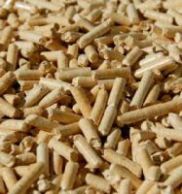Bran Pellets
| Infobox on Bran Pellets | |
|---|---|
| Example of Bran Pellets |  |
| Facts | |
| Origin |
|
| Stowage factor (in m3/t) | 1.45 - 1.90 m3/t (bulk) |
| Angle of repose | - |
| Humidity / moisture | 9.4 - 13.3%. Oil content: 1.7 - 2.1% |
| Oil content | - |
| Ventilation | See text |
| Risk factors | See text |
Bran Pellets
Description
Compacted husk of products such as wheat.
Wheat bran pellets are made from wheat bran, a by-product of flour and grits production, which chiefly consists of husks and variable proportions of the endosperm, by adding a suitable binder (e.g. 1 - 3% of molasses, fat or colloidal clays) and then pressing the composition under high pressure in pelletizing machines or extruders to form cylindrically shaped pellets. From a transportation standpoint, pellets generally have the same characteristics as the original plant residues, in particular in terms of the product's oil and water content. A distinction is drawn between expeller pellets and extraction meal pellets depending on their origin (See Expellers and Extractions).
Application
Used as animal feed
Shipment / Storage
Bran pellets can be bagged, baled or (mostly) shipped in bulk. The product is susceptible to water damage, causes fermentation and red beetle infestation. Subject to caking that looks like water damage.
Product intended for shipping must be adequately matured. The time required for maturing is determined by the oil content.
Certificates relating to the moisture and residual oil content and the maturing time of the product should be provided by shippers. Confirmation or certification should also be obtained as to whether the starting material is expeller or extraction meal. Residual oil contents of < 1.5% indicate extraction meal, while higher oil contents indicate expeller.
During overseas transport the temperature must constantly be measured at various depths in the hold(s). If the temperature rises above 55°C and any further increase is observed, countermeasures must be taken, e.g. tight closing of all hatch openings and injection of CO2 or inert gas.
Wheat bran pellets are often shipped at a water content of 12%. Since the critical water content is > 14%, migration of moisture into the cargo starts if the water content rises by only 2%.
Wheat bran pellets release large quantities of water vapor during transport. Wetting and mold damage occur especially in pellets which have been steam-treated, pelletized and cooled and, as a result, were loaded too moist and too hot. Pellets treated in this manner are unstable and have a tendency to self-heating in particular due to microbiological activity.
Since moisture encourages mold, mustiness and self-heating, pellets must be protected from all forms of moisture (seawater, rain and condensation water).
Stow cool and dry. Mechanical ventilation of the stowage spaces must be possible. Surface ventilation is recommended. As with bulk cargoes of expeller, pellets are also often not ventilated.
In order to avoid moisture damage on the surface of the cargo, ventilation must not be performed with cold external air. The ventilation system must then be switched to return air.
Due to the principal causes of self-heating in vegetable pressing residues, two problems arise with regard to ventilation:
At an excessively high product water content, localized overheating caused by enzymes or bacteria results in self-heating. The resultant heat must be dissipated by constant ventilation by means of a good ventilation system. Drying by ventilation is useful, but its effectiveness is questionable because, as heating proceeds, increasingly large quantities of water vapor are released. The activity of the initiating microorganisms is not suppressed by non-ventilation of the hold as some of the thermophilic (= heat-loving) bacteria are anaerobic organisms (which require no oxygen supply to stay alive).
Ventilation is helpful in the first case, but hazardous in the second. The correct ventilation measures may only be implemented if the characteristics (loading temperature, water content, duration of prior storage) of the cargo are known. However, if a large batch is made up of various sub-batches, it is entirely possible for both the above-stated causes to occur in the same heap of cargo.
Solvent vapors from pellets made from extraction meal are heavier than air and do not take the form of surface vapors; as a result, they cannot rise upwards and be dissipated by surface ventilation. They may theoretically be eliminated by ventilation only if the temperature of the cargo rises due to self-heating, causing the vapors to rise in the cargo, in which case, however, direct surface ventilation would be inappropriate.
If the oxidation processes under way in the hold are vigorous, it is not possible to dissipate the quantity of heat generated by ventilation. This particularly applies if a sub-batch susceptible to oxidation with a low water content is loaded next to a sub-batch with a high moisture content.
Risk factors
- Odor
- Contamination
- Infestation
- Wheat bran pellets are liable to the risk of self-heating/spontaneous combustion.
Reference is made to the relevant IMO regulations of hazardous cargo (with reference to Seedcake).











